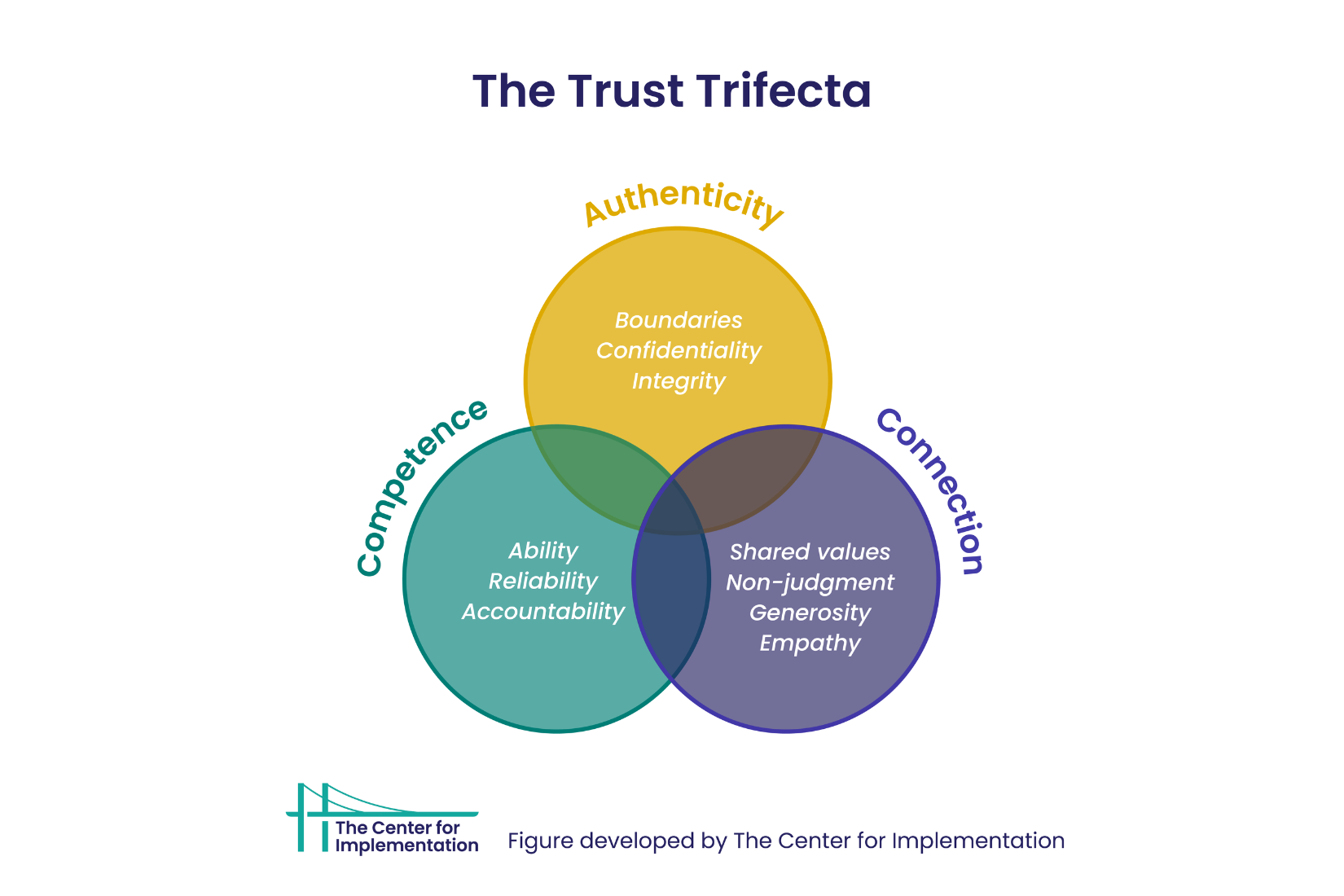Cultivating Trust: The Trust Trifecta Framework
By Dr. Julia E. Moore, Executive Director & Dr. Sobia Khan, Director of Implementation
Note: We have updated our website since this article was published. As a result, you may have been redirected here from a previous URL. If you are looking for the article, “Implementation Tips & Tricks: How to Show Trust in a Hybrid World” by Erica Dhawan, please click here.
Implementation is inherently a social process. Relationships are essential at every level. A core aspect of building strong relationships for implementation involves building trusting relationships.
For almost a year now, we have been delving deeply into this topic and developing our understanding of the core components of trust at the individual level, within organizations, and between organizations. As a result of this research, we have adapted existing frameworks to develop the Trust Trifecta framework.
This framework highlights that there are 3 essential components that need to be in place in order to trust other people: competence, connection, and authenticity (adapted from the Trust Triangle described by Frances X. Frei and Anne Morriss in the Harvard Business Review and Brené Brown’s definition of trust).
Below are short definitions of each component along with examples of how they show up in our relationships.
Cultivating trust: Competence
Competence includes 3 elements: ability, accountability, and reliability. We trust people when we think that they have the knowledge and skills to do what they are being asked to do (i.e., they have the ability to do it). We trust people when they hold themselves accountable, meaning they own their own mistakes and apologize when appropriate. We trust people when they are reliable and follow through by doing what they said they would do. Competence also runs in two directions: 1) your trust in their competence and 2) their trust in your competence. Both need to be in place to build a strong and trusting relationship.
Cultivating trust: Connection
Connection is about building a link with the other person. This starts by identifying shared values and shared interests. It is also easier to connect with people when both parties enter interactions with a mindset of non-judgment. Taking this even one step further, it is easier to build trust when we attribute other people’s words and actions with the best possible intentions. Finally, connection also involves having and expressing empathy – this means being able to take the perspective of another person, even if you do not agree with them, and being able to communicate that you can see their perspective and understand their feelings.
Cultivating trust: Authenticity
Authenticity requires vulnerability, even in the workplace. Authenticity means knowing your own motives and being able to share those motives. Authenticity means having personal boundaries, maintaining those boundaries, and respecting the boundaries of the other person. Authenticity involves keeping information confidential, and having integrity, meaning that you are living by your values.
Selecting actions to cultivate trust
Knowing these core elements of trust is a good first step in building trusting relationships, but this alone cannot create trusting relationships, since this framework does not provide actions for us to take. This framework serves as a foundation for understanding strengths and opportunities in relationships, so that we can select specific actions to show up authentically, build connections, and highlight the competence in others, while also demonstrating our own competence.
Based on this framework, we have been building out an exciting new tool for our upcoming course, Cultivating Trust and Navigating Power, that presents a series of actions you can select based on a guided assessment of your relationships. We’ve compiled these valuable actions and connected them to the framework to make a clear path for your next steps. For example, if you want to foster connection, consider actions like non-verbal communication that is culturally and contextually appropriate (e.g., smiling, nodding, emojis). Showing up authentically might involve expressing vulnerability or explicitly stating your motives. Ways you can show others you trust them are by identifying and highlighting their strengths or accomplishments. These are just a few examples of the actions we’ve linked to each core component of trust.
In the process of researching actions for cultivating trust, we came across Erica Dhawan’s powerful book, Digital Body Language. It provides specific examples of ways to cultivate trust in a virtual environment, something that’s especially relevant for all of us right now.
This article was featured in our monthly Implementation in Action bulletin! Want to receive our next issue? Subscribe here.

